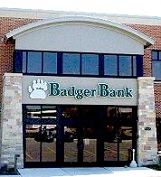| PFI Conversation: Profitability Comes in a Number of Forms |
 Badger Bank, a member of the FHLBank Chicago, has served its community in Fort Atkinson, Wisconsin, since 1884. Today it has four branch locations in its region, which consists of small towns and densely populated rural areas between Milwaukee and Madison. The bank, which holds $115 million in assets, has expanded its use of the MPF Program over the past eight years; it currently has a servicing portfolio of nearly $140 million in MPF loans and originated $90 million last year. MPF in Focus recently spoke with Jim Seidl, Vice President–Lending, who came to Badger Bank three years ago. Badger Bank, a member of the FHLBank Chicago, has served its community in Fort Atkinson, Wisconsin, since 1884. Today it has four branch locations in its region, which consists of small towns and densely populated rural areas between Milwaukee and Madison. The bank, which holds $115 million in assets, has expanded its use of the MPF Program over the past eight years; it currently has a servicing portfolio of nearly $140 million in MPF loans and originated $90 million last year. MPF in Focus recently spoke with Jim Seidl, Vice President–Lending, who came to Badger Bank three years ago.
Q: What were the circumstances that led you to begin using the MPF Program?
Jim: The MPF Program was already in place at my previous bank when I arrived there 13 years ago. At that time the program was fairly new, and the bank had brought it on board because it was a means for smaller banks to compete with the heavyweights.
Q: What are some of the benefits you've realized?
Jim: Now we can compete on a level playing field with the largest banks in the country, on the basis of service and quality rather than just pure pricing. It also allows us to keep the servicing on the loans, which most mortgage clients value, and the MPF Program has streamlined the servicing program to such a degree that even small banks can afford to do the servicing.
Q: How would you rate your experience with the MPF Program?
Jim: I would rate it as truly superior. People get caught up in how profitable the products are, but one thing that’s rarely discussed is that the service we get from the MPF Program is far beyond anything we would have anyplace else. Community lenders are focused on their local community; we live and breathe small business, residential properties, all the things you deal with at a community level. And they are the same way—they really know their PFIs on a personal level. When I pick up the phone to get a question answered, I often reach service representatives I’ve worked with for many years. They’ll ask, “Hey Jim, how are you doing? How’s your daughter doing?” While giving quick and knowledgeable advice, they retain a personal touch. It’s astounding in the bustle of this business and it fosters exceptional collaboration.
They listen to what their PFIs ask for, and they really deliver. For example, they recently added a service-released program, which is great for a small community bank. I have clients asking for mortgages in California, so we can handle the origination and let the servicing go to a nationwide servicing corporation. And they’ve supported us with things like government programs in rural development that are unknown to a lot of banks.
 What do you feel are the best benefits? What do you feel are the best benefits?
Jim: Profitability is the best benefit, and profitability comes in a number of forms. MPF is a very price-conscious program, to the point where we can compete equally without having to sacrifice income. The quality of the loans we’re originating—because of the MPF Program's underwriting standards—are such that the default category is a tiny fraction of what you might see in other loan portfolios, so our losses on these products are small, and that keeps profitability high. The other aspect is that because of the service we get from them, we are quickly able to defuse problems, and that saves my staff a lot of time. |
|